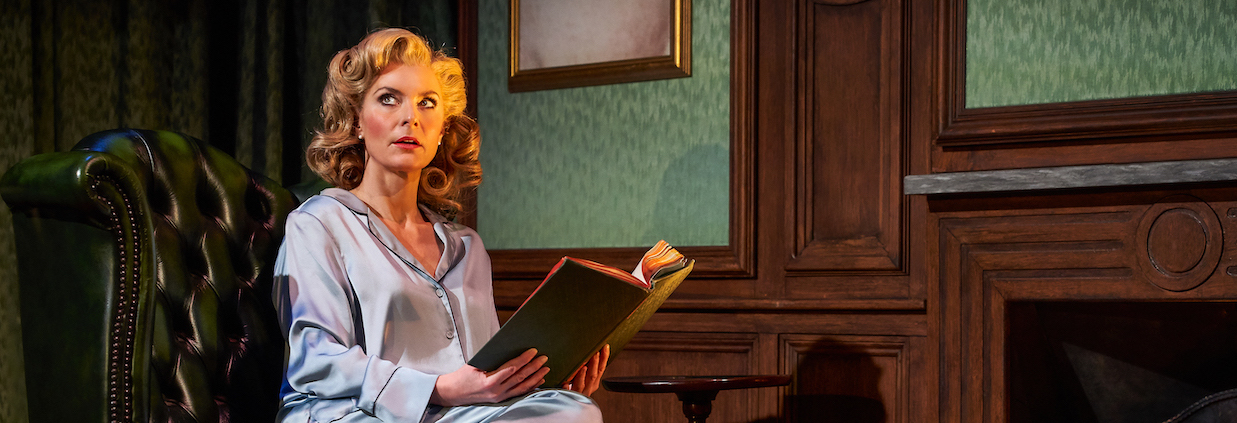
Digital Editor Tamzin Meyer and Culture Writer Charley Davies join hands to review The Cat and The Canary, a murder mystery play that had (one of) them shrieking in the auditorium
The Cat and the Canary came to The Alexandra theatre yesterday (4th October) to deliver the audience a play full of comedy, horror, and fright. It certainly got the balance just right, allowing us to quite literally scream as books fell from bookcases, lights flickered, and a maniac ran loose whilst also allowing us to laugh at just the right time. The comedy element was scattered carefully throughout the play so that the audience could have a slight breather from the tension with the plot being complex and well thought out, providing the ultimate mystery.
Being based on a film of the same name, this murder-mystery revolved around the group of six ‘last living descendants of Cyrus Canby West’, who unite at Cyrus’ Bodmin estate 20 years after the death of the gentry-man, in the hope of claiming the aforementioned estate, Cyrus’ bonds, and his monetary assets. But when these members of extended family are welcomed into the house by Cyrus’ loyal and ironically named housekeeper, Mrs Pleasant, the show becomes entrenched in foreboding as the supposed ‘evil’, which Pleasant refers to, still pervades the air…
One of the most clever features of the set was the single, loose book about ‘fear’
The Cat and the Canary succeeded in capturing the eery isolation of a Bodmin Moor manor house. The amass of white smoke which opened the piece alluded to cold Cornish air as well as capturing the evil spirits deluding Annabelle throughout the play. The two, alternating sets — the main drawing room and Annabelle’s bedroom — created the claustrophobia needed for a drama set within the confines of a domestic space across one, stormy night. The drawing room was composed of wood-panelled bookcases which rose all the way to the flies and dominated anyone standing next to it – a fail-safe way to tick the ‘haunted house’ box. One of the most clever features of the set was the single, loose book about ‘fear’ which suddenly shot from the seemingly two-dimensional bookcase onto the floor when Annabelle was alone in the drawing room. This moment was convincing enough that one of us, regretfully, shrieked in the auditorium; however, we will keep whoever belted this noise out a mystery.
Whenever the warm bulb-lights on stage flipped to the cool pools or spotlights, we anticipated a scare […] so much so that it became habitual for us to associate abrupt technical changes with subsequent scares
Lighting also played a pivotal part in the mood-shifts in what was often which a humorous play, especially through use of colour. Whenever the warm bulb-lights on stage flipped to the cool pools or spotlights, we anticipated a scare from the asylum escapee, so much so that it became habitual for us to associate abrupt technical changes with subsequent scares. Lighting also played an important role in reflecting Annabelle’s psyche. By the end of the play, where all seemed resolved, the shift to cool light worked in tandem with the reprise of the haunting song from Annabelle’s childhood. As Annabelle resisted the inclination to be scared as this song played and cool pool pervaded the air around her, we sensed her overcome the identity her cousins plotted to cave her into of the destructively flighty canary.
The dysfunctional family consisted of characters that all had quite distinct personalities. All of them had the potential to be heir which made the upcoming mystery difficult to solve – all had the motive to be causing havoc in the eerie house. The casting of these characters was clever as all of the cast brought their characters to life; they all understood their contribution to the plot and bounced off each other wonderfully.
The star of the show was indeed Tracy Shaw who played th heir Annabelle West, encapsulating her fear stricken celebrity persona to a tee as others in the house tried to con her out of her entitlement. Shaw certainly draws herself towards the psycho, with the ‘cat’ on the loose being somewhat creepier than Richard Hillman, alluding to her time in Coronation Street. Bond girl, Brett Ekland was just as much a crucial part of the play as her character Mrs Pleasant was a part of the house’s furniture. She made sure that the audience knew there was something very creepy about her from the offset and perfectly executed her role as housemaid throughout.
The ending was unexpected, yet slightly rushed – but this added to the comical element of the play. It certainly reminded us of The Murder on the Orient Express where there was no simple answer to the whodunit mystery at hand. We were certainly pointing our fingers at Mrs Pleasant although we could not have been further from the truth… or could we?
In all, the play had us all on the edge of our seats whilst also allowing us some time for reprieve in between. At times, more action would have been an added treat, but the intense scenes that were incorporated were worth the wait.
Enjoyed this? Read more theatre reviews on Redbrick Culture!


Comments